Cai Guo-Qiang’s “The Spirit of Painting” Opens at the Prado Museum
Posted by Cai Studio in Uncategorized on November 7, 2017
Historic Exhibition Explores the Past and Future of the Medium

Ignition of gunpowder painting The Spirit of Painting at the Salón de Reinos (Hall of Realms), Madrid, 2017. © Museo Nacional del Prado
(Madrid – October 25, 2017) Cai Guo-Qiang and The Prado Museum are proud to announce the opening of The Spirit of Painting. Cai Guo-Qiang at the Prado a solo exhibition by the acclaimed contemporary artist. This exhibition marks the first time an artist has created on-site at the museum, and only the second time the museum has hosted a solo exhibition of a living artist.

The Spirit of Painting, 2017. Gunpowder on canvas, 300 x 1800 cm. © Museo Nacional del Prado
The Spirit of Painting arose from the artist’s lifelong admiration of El Greco, and is Cai’s first solo exhibition focused solely on painting in over 30 years. For the first time, Cai measures himself against the great masters of the Western pictorial tradition through his innovative and unusual artistic technique. The Spirit of Painting will be on view through March 4, 2017.


Top Left: íñigo méndez de vigo y montojo, Minister of Education, Culture and Sport, speaking before the ignition of gunpowder painting The Spirit of Painting at the Salón de Reinos (Hall of Realms), Madrid, 2017. Photo by Yvonne Zhao, courtesy Cai Studio Top Right: Cai Guo-Qiang with Jack Ma, after ignition of gunpowder painting The Spirit of Painting at the Salón de Reinos (Hall of Realms), Madrid, 2017. Photo by Wen-You Cai, courtesy Cai Studio Bottom Left: Cai Guo-Qiang with Miguel Falomir, Director of the Prado Museum, íñigo méndez de vigo y montojo, Minister of Culture, José Pedro Pérez-Llorca, President of the Royal Board of Trustees of the Museo Nacional del Prado, and José Manuel Entrecanales, Executive Chairman of ACCIONA Bottom Right: Cai Guo-Qiang speaks at opening press conference. Museo Nacional del Prado, Madrid, Spain, 2017. Photo by Sang Luo, courtesy of Cai Studio.
For The Spirit of Painting, Cai transformed the museum’s Hall of Realms into his studio, producing eight works inspired by the memory of the former palace of Philip IV and in dialogue with the Great Masters represented in the museum’s collection. The artist’s residency, which took place in the weeks leading up to the exhibition’s opening, concluded on the 23rd with the creation of The Spirit of Painting, a monumental painting measuring 3 x 18 meters.

Exhibition views of The Spirit of Painting. Cai Guo-Qiang at the Prado at Museo Nacional Del Prado, Madrid, 2017. Photos by Wen-You Cai, courtesy Cai Studio
In addition to nineteen paintings made in New York, Cai created The Spirit of Painting and seven other works in the Hall of Realms. Also on view are oil and acrylic early works, a selection of sketches, and drawings on matchboxes by the artist’s father, Cai Ruiqin.

Left: Cai Guo-Qiang during the creation of gunpowder painting Day and Night in Toledo at the Salón de Reino (Hall of Realms), Madrid, 2017. © Museo Nacional del Prado Right: Cai Guo-Qiang and volunteers preparing for gunpowder painting The Spirit of Painting at the Salón de Reino (Hall of Realms), Madrid, 2017. Photo by Yvonne Zhao, courtesy Cai Studio
The Spirit of Painting will allow visitors to explore Cai Guo-Qiang’s lifelong dialogue with the Western pictorial tradition, particularly the spirit of El Greco. This dialogue began during Cai’s years as a student and has continued to the present day; a continuity evident in the selected early works and documentation of the 2009 journey Cai undertook to retrace El Greco’s travels from his native Crete to Venice, Rome, and, finally, Toledo.
The exhibition is an extended defense of the particular characteristics that define the “spirit of painting”: the artist’s sensibility, craftsman-like skill, and the sense of adventure when starting work on a blank canvas. The exhibited works broaden Cai’s own singular spirit of painting and, at the same time, consider a way forward for contemporary painting. They form a rhythmic progression that evokes a compositional structure common in classical and modern Chinese literature and music. This formula, known as Qi cheng zhuan he, is present in the different sections of the exhibition:

Exhibition view of The Spirit of Painting. Cai Guo-Qiang at the Prado at Museo Nacional Del Prado, Madrid, 2017. Photo by Wen-You Cai, courtesy Cai Studio
Rise (Qi)
The first room illustrates the relationship and dialogue between Cai Guo-Qiang and the spirituality of El Greco. This connection inspired Cai in the early stages of his painting career, and now acts as the beginning of the exhibition.
Day and Night in Toledo was the first work that Cai created in the Salón de Reinos. Cai reimagines what he saw when revisiting Toledo in early 2017 — the city from night to dawn, morning to sunset, and back to the night. The town, cathedral, valleys, and skies in the painting look as they did in El Greco’s time, forming a mirage on canvas. “As if, through an El Greco-esque energy, the past and present are overlapping in an undefined time and space,” Cai described.

Day and Night in Toledo, 2017. Gunpowder on canvas, 260 x 600 cm. Photo by Yvonne Zhao, courtesy Cai Studio
Painting El Greco’s Apostolado, No. 8, 9, 6, 3, 10, 7 emanate a sense of ceremony unique to classical painting. For each Apostle, Cai arranged gunpowder between two canvases, laid face-to-face on the ground. Ignited together, two paintings emerge—the lower canvas is more figurative and the upper one more abstract. “As though extracting an imprint of spirituality,” Cai explained.

Painting El Greco’s Apostolado No. 8, 9, 6, 3, 10, 7, 2017. Gunpowder on canvas, 152.5 x 244 cm each. Photo by Yvonne Zhao, courtesy Cai Studio
With the group of studies In Search of El Greco, No. 3, 6, 8, 9, Cai experiments with gunpowder and explosion to better understand El Greco’s painting technique, including the flow and expression of color, light, and energy.

Black Ceremony, 2017. Gunpowder on canvas, 300 x 450 cm. Photo by Yvonne Zhao, courtesy Cai Studio
Development (cheng)
The second room inherits the spirituality of Rise, but is more personal and pure in its artistic expression. The works displayed are dedicated to the artist’s loved ones who have passed away in recent years.
In Black Ceremony, Cai explodes on a blank space his desolation and helplessness at losing his hundred-year-old grandmother, his father, and father-in-law in the past few years — it is more abstract, more boundless; in The Distant Clouds, he uses raw black gunpowder and gunpowder fuse from Valencia to express his pining for and remembrance of his loved ones. Three other abstract paintings convey the surging of emotions, and at the same time reveal the artist’s painstaking study of the materials and techniques involved in painting with gunpowder.

Cai Guo-Qiang and and his wife Hong Hong Wu standing before The Distant Clouds. The work commemorates the loss of Cai’s close relatives, and is installed opposite the gunpowder painting The Spirit of Painting. Museo Nacional Del Prado, Madrid, 2017. Photo courtesy Cai Studio

Blue, 2017. Gunpowder on canvas, 183 x 152.5 cm. Photo by Yvonne Zhao, courtesy Cai Studio
Shift (Zhuan)
The third room suddenly opens and brightens, bringing a new energy; it erupts with color and passion, unleashing “the spirit of painting.”
In Mountain in Heat, layer upon layer of aphrodisiac mushrooms culminate into a mountain that bursts forth with desire. The artist strives to achieve a sense of richness and depth on the canvas, straining between the thinness and simplicity of contemporary art and the profundity and harmony of classical painting, seeking to convey a new aesthetic.

Mountain in Heat, 2016. Gunpowder on canvas, 239 x 450 cm. Photo by Yvonne Zhao, courtesy Cai Studio
Last Carnival developed from Cai’s study of the Prado’s collection of Rubens, specifically his ability to capture the dynamic movements of man and beast. At the same time, it resonates with Bosch’s The Garden of Earthly Delights. Different species of animals have succumbed to interbreeding, drawing forth an environmental theme in which living beings continue to frolic even when only one pool of water remains on the planet.

Last Carnival, 2017. Gunpowder on canvas, 280 x 750 cm. Photo by Yvonne Zhao, courtesy Cai Studio
Black Poppy features nine canvases; on each succeeding canvas, Cai decreased the amount of black color gunpowder until the coolly elegant black is lifted to reveal the scarlet repressed beneath. The work captures the passage of changing time. “Painting needs to express energy; here, the energy expresses itself,” Cai explains.

Black Poppy, 2016. Gunpowder on canvas, 152.5 x 122 cm each. Photo by Yvonne Zhao, courtesy Cai Studio
The Spirit of Painting was the artist’s grand finale in the Salón de Reinos. Following more than two years spent studying painting and immersing himself in the spirit of painting found in the Prado’s collection, Cai completes the exhibition with a fearless and cathartic liberation through this work. “I imagined the spirituality bestowed upon me by Titian, El Greco, Velázquez, Rubens, and Goya — through this, I imagined a daytime fireworks event for each of them, and together they constitute five chapters,” Cai says. “I envisioned the fireworks effects for each master, and my goal is to capture the grandeur and immense power of outdoor explosions within the 18m-long canvas. I look to unleash my imagination of the masters’ spirit of painting through fierce interflowing of abstract colors; employing their iconic symbols and upturning them in one grand explosion…

The Spirit of Painting, 2017. Gunpowder on canvas, 300 x 1800 cm. Photos by Wen-You Cai, courtesy Cai Studio
Unification (He)
The fourth room accumulates energy; echoing Rise, it registers a higher level of spirituality.
Salón de Reinos… was ignited in the exact location captured on the canvases. It seizes the shadows of artists such as Velázquez, who competed in the Salón de Reinos. In addition to expressing his reveries at dusk while creating works in the hall over the past month, the artist also includes a phantasmal black line, subtly suggesting a blurring of time-space dimensions.

Salón de Reinos…, 2017. Gunpowder on canvas, 360 x 600 cm. Photo by Yvonne Zhao, courtesy Cai Studio
Cai explained that prior to creating Palmyra, “I first attempted to use gunpowder to reimagine Goya’s The Third of May, in order to understand its energy and tension.” This work further acts as “a gesture of empathy from the Prado to a fellow landmark of ancient civilization in the latter’s time of misfortune.”

Palmyra, 2017. Gunpowder on canvas, 240 x 450 cm. Photo by Yvonne Zhao, courtesy Cai Studio
Exhibition corridor between Gallery C and D
A selection of works provides further insight into the origins of and stories behind the exhibition. It begins with Cai’s father’s drawings on matchboxes and two of Cai’s early works in oil and acrylic. This is followed by a recounting of his 2009 travels with his elder daughter, retracing El Greco’s footsteps from his birthplace in Crete to Italy and to Toledo, his final resting place. Select sketches inform the artist’s relationship with the Prado’s collection as well as the creative process behind The Spirit of Painting.
On his father’s matchboxes: “As a child, I watched my father transform the commonplace scenery of our hometown into formidable mountaintops and waterfalls, using tiny matchboxes as his canvas. Throughout my journey as an artist, these matchboxes helped me to understand that painting is about depicting the heart and mind: a thousand acres can exist between two fingers. The fire of Nature symbolizes my continuation of my Eastern and Western predecessors — it traverses cultural and geographical boundaries and returns us to the origin.”

Exhibition view of Cai Guo-Qiang’s early works and father’s Untitled (Matchbox Drawings) at Museo Nacional Del Prado, Madrid, 2017. Photo by Wen-You Cai, courtesy Cai Studio
Isabel Coixet, one of Spain’s most prolific and internationally minded filmmakers, has produced a 60-minute documentary film to accompany the exhibition, a condensed 20-minute cut of which will also be on view. “Through the film, viewers will witness the two-year creative process behind the exhibited works,” Coixet said. “They will be able to holistically experience the dynamic charisma and singular beauty of the artworks, and gain an understanding of the artist’s profound pursuit of and reflections on the art of painting.”
Filming took place in New York City, where Cai Guo-Qiang lives and works, on Long Island, in Madrid, during the artist’s residency in the Hall of Realms, and in Valencia and Toledo. It is produced by Miss Wasabi Films for the Prado, and will be released worldwide in late 2017.
The Spirit of Painting will be open Monday through Saturday from 10am to 8pm, and Sundays and public holidays from 10am to 7pm. Guided tours of the exhibition are also offered on Wednesdays at 11am and 5pm.
Exhibition Information
The Spirit of Painting.Cai Guo-Qiang at the Prado
Host: Prado Museum
Location: Prado Museum, Madrid, Spain
On-Site Creation: October 2-23, 2017 at the Salón de Reinos, Madrid, Spain
VIP Opening: October 24, 2017
Exhibition Dates: October 25, 2017 to March 4, 2018

Cai in front of Velázquez’s Las Meninas, 2017. Photo by Javier Molina, courtesy Cai Studio
Cai Studio
- www.caiguoqiang.com
- www.facebook.com/cgqstudio/
- Instagram: caistudio
- Wechat:蔡国强工作室
Prado Museum
- https://www.museodelprado.es/en
- www.facebook.com/museonacionaldelprado/
- Instagram: museoprado
Fireflies opens to the Public with a performance directed by Cai Guo-Qiang
Posted by Cai Studio in Uncategorized on October 13, 2017
Philadelphia, PA – On September 14th at 8pm, Cai Guo-Qiang’s largest public art project in the United States in the past decade opened on the Benjamin Franklin Parkway. In a one-time twenty minute performance directed by Cai Guo-Qiang, local participants steered 27 pedicabs adorned with nearly 1,000 multi colored lanterns of various shapes, hand-crafted in the artist’s hometown of Quanzhou. For this occasion, Cai designed a choreography based on the flowing and languorous movements of the lanterns. The “fireflies” followed the variations of a musical composition into the gathering darkness of the Parkway as though spinning and dancing into a late summer carnivalesque dream. At the conclusion of the performance, a crowd of over 1,000 spectators flooded the Parkway to congratulate the drivers and take selfies with their favorite lanterns. Fireflies is a humorous tribute to the centennial of the artery. As the city’s cultural axis with profound political meaning; it brings participants and spectators to reflect on the relationship between public art, and the city, its people and society.
“mesmerizing…the event lasted only 20 minutes but generated a feel-good response.” — The New York Times
“it was just so charming and it made you laugh,” said Lauren Raske, 31, an event planner
“It’s a nighttime activity and the mystique of the evening makes it a little romantic,” said Nicole Dugan, a physical therapist, “Even on this small scale, it was really spectacular.”
“This is not just from Cai’s childhood but from everyone’s childhood,” – Sadigaa Horton, 45, pedicab driver

Fireflies performing at the opening ceremony, Philadelphia, 2017. Top:Photos by Jeff Fusco Photography, courtesy Association for Public Art Middle Left:Photo by Yvonne Zhao, courtesy Cai Studio Middle Right:Photo by Meredith Edlow, courtesy Association for Public Art
Spectators with Fireflies after the opening performance, Philadelphia, 2017. Bottom Left:Photo by Jeff Fusco Photography, courtesy Association for Public Art Bottom Right:Photo by Wen-You Cai, courtesy Cai Studio
The opening night preludes a month’s duration of the public component of Fireflies: commencing September 15th, members of the public are invited to board the vehicles to take rides up and down the Parkway from Sister Cities Park to Iroquois Park near the Philadelphia Museum Art. The rides will be operated for four weeks, Thursdays through Sundays, between 6-10pm, until October 8, 2017. As of September 15th, all the advance time slots have been reserved, but walk-ins remain available. Fireflies is commissioned and organized by Association for Public Art with curator Lance Fung of San Francisco’s Fung Collaboratives.

Spectators with Fireflies after the opening performance, Philadelphia, 2017. Photos by Jeff Fusco Photography, courtesy Association for Public Art Middle Left:Photo by Meredith Edlow, courtesy Association for Public Art
Cai Guo-Qiang has an unforgettable relationship with the city of Philadelphia—his explosion event Fallen Blossom in 2009 was seen in front of the façade of the Philadelphia Museum of Art, located at the end of the iconic Benjamin Franklin Parkway– in homage of the late director Anne d’Harnoncourt. Fireflies was an entirely new and grassroots experience. Responding to an open call, several Philadelphians partook in the performance and project as pedicab operators, while visitors from the city and around the world witnessed the performance and rode the pedicabs. Lanterns in the shapes of cars, submarines, cosmic ships, slippers, sushi, donuts as well as little roosters, extraterrestrials, and emoticons were fabricated in Quanzhou before being shipped thousands of miles away to be installed in Philadelphia. Shuttling back and forth on the Parkway aligned with flags from hundreds of different countries, the fireflies remind people of the countless cultures and peoples that take root in the Unites States. Over the next four weeks, the pedicabs will generate encounters between peoples of various backgrounds.
This summer, Cai Guo-Qiang spent several days in Philadelphia in preparation for the opening performance. During the dress rehearsal, a long procession of “fireflies,” generating a trail of bright light, was escorted by the police from the production headquarters in Olde Kensignton, through Ludlow and Poplar to Center City all the way to the Parkway. The neighborhoods became alive with the passing of the fireflies; city dwellers and local residents spontaneously stopped to cheer and take photographs, enjoying the excitement of a chance encounter with public art…
“Small roosters and red stars…a lot of the lanterns you see here resemble those I used to play with as a kid in Quanzhou,” said Cai Guo-Qiang, “they are the inextinguishable fireworks of my childhood…For the centennial of the Benjamin Franklin parkway, I didn’t wish to create a large scale celebration, but rather a playful and light evening, to return the Parkway to the people and let them participate in the creative process.”
The musical composition for Firelfies was edited by Liu Ruomu, an undergraduate student at Emery College, from the original official state song “Pennsylvania” by Eddie Khoury and Ronnie Bonner. A 9-minute documentary sharing the same title was directed by Shanshan Xia.
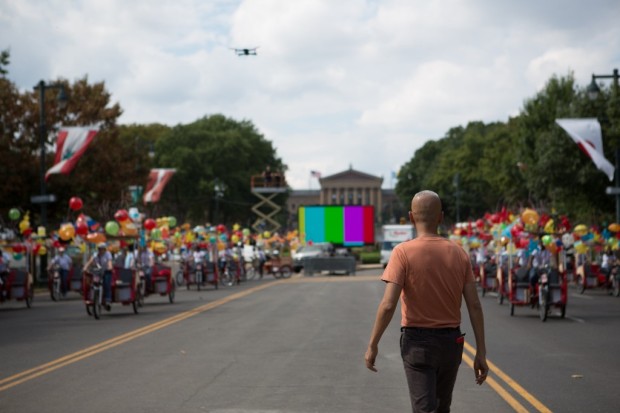
Fireflies rehearsal, Philadelphia, 2017. Photo by Lin King, courtesy Cai Studio
Cai Guo-Qiang: Fireflies information:
Enjoy FREE one-way Fireflies pedicab rides move along the Benjamin Franklin Parkway from Iroquois Park to Sister Cities Park or vice versa.
September 15 – October 8, 2017
Thursdays through Sundays from 6-10pm
The vehicles can accommodate up to two passengers, and each trip takes approximately 15 minutes. Walk-ups are welcome, but online reservations can be made here.
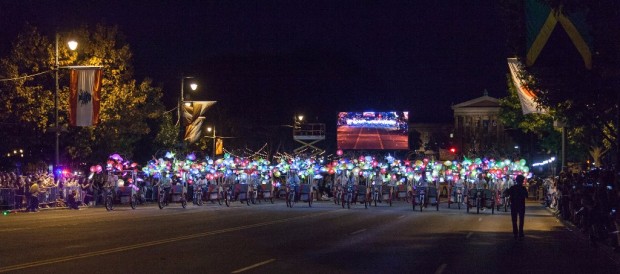
Fireflies performing at the opening ceremony, Philadelphia, 2017. Photo by Wen-You Cai, courtesy Cai Studio
For more information, please visit
www.associationforpublicart.org/fireflies
Cai Studio
• http://www.caiguoqiang.com/
• Facebook: http://www.facebook.com/cgqstudio/
• Instagram: caistudio
Cai Guo-Qiang: October opens in Moscow
Posted by Cai Studio in Uncategorized on October 13, 2017

Moscow – The Pushkin State Museum of Fine Arts announces the long-anticipated opening of renowned international artist Cai Guo-Qiang’s first solo exhibition in Russia: October. On the occasion of the October Revolution’s centenary, Cai specifically created for the Pushkin Museum a series of bold new works that reflect on the role of individuals in history and the relationship between individual dreams and collective ideals. The exhibition will be held with the support of Sberbank and will be on view in the main building of the museum from September 13 to November 12, 2017, as a crucial component of the “Pushkin XXI” project.
During the past two weeks prior to the exhibition’s opening, local passers-by often gathered outside the Museum to photograph the installation Autumn. Their posts on social media stirred curious discussions about the classical architecture’s transformation. A 16m-high mountain constructed out of hundreds of stacked baby cradles, cribs and strollers gradually rose at the entrance of the centuries-old museum, engulfing the front steps and colonnade. Then over three days, a crane planted one to two white birch trees of 3-4m in each cradle and birch saplings in each stroller. The larger trees shelter the small, forming a verdurous birch forest. During the installation process, this forest has already begun to yellow from the oncoming autumn. Over the course of the exhibition, the fallen leaves will blanket the mountainside, revealing the white trunks of the birches and the Constructivist-like structure of the mountain itself.

Top: Autumn, 2017. Strollers, cribs, baby beds, birch trees; Approximately 23 m wide x 15 m depth x 15 m high. Installation view of Autumn at The Pushkin Museum of Fine Arts, 2017. Photo by Yvonne Zhao, courtesy Cai Studio. Bottom Left: Installation process at The Pushkin Museum of Fine Arts, 2017. Photo by 33 Studio, courtesy Cai Studio. Bottom Right: Detail of Autumn. Photo by Yvonne Zhao, courtesy Cai Studio.
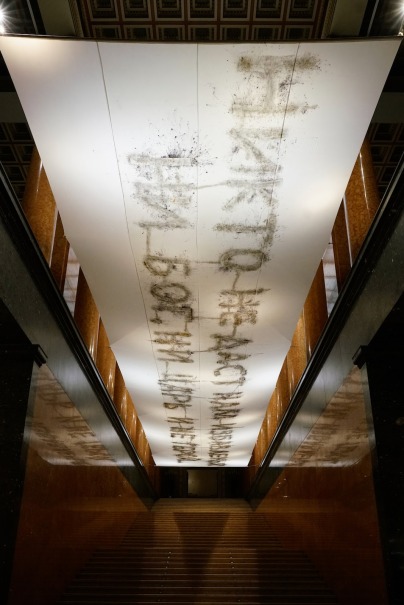
The Sound, 2017. Gunpowder on silk; 4.7 x 20 m. Installation view at The Pushkin Museum of Fine Arts, 2017. Photo by Tatsumi Masatoshi, courtesy Cai Studio
Literally obstructing the museum entrance, the dominating Autumn marks the beginning of an entirely original visual experience. Inside, the artist continues to manipulate the museum’s space. Hovering over the central staircase is The Sound, a 20m-long piece of silk scorched with gunpowder calligraphy that divides the lofty space in half. The two-dimensional art of calligraphy and painting is transformed into a poetic, spatial installation work filled with momentum. As viewers ascend the staircase, hovering overhead on the smooth white silk is a cautionary lyric from The Internationale: “There are no supreme saviors: neither God, nor tsar, nor hero!” By the time the words seem within reach, the visitor will have entered the White Room.
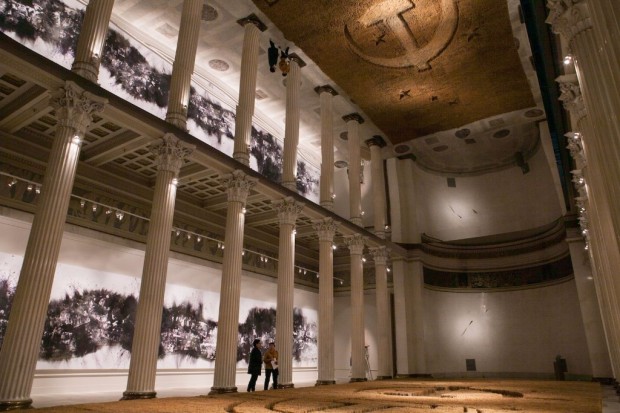
Land, 2017. Reed, plywood, reflective polymer film; Crop circle: Approximately 8 x 19.8 m, Reflective polymer film: 8 x 20 m. Installation view at The Pushkin Museum of Fine Arts, 2017. Photo by Yvonne Zhao, courtesy Cai Studio
The ceiling is covered by a silver mirror, multiplying the already expansive space. Two 20m-long gunpowder paintings on the facing walls, River and Garden, surrounds the field of Land in the center of the room. With this installation, created from nearly three million stalks of golden reed, Cai hopes to recreate the sense of mystery found in the Soviet films and Russian paintings of his childhood — the sunlight filtering through the clouds and shining on the wheat field, and likewise projecting into an adolescent mind the romantic ideas with regard to the freedom and beauty of life. Only through the reflection in the mirror overhead can viewers discern the symbols hidden within the crop circle. Simultaneously reflected are the countless images of civilians embedded within the black-and-white Riverof turbulent history, the colorful poppies, carnations, and Soviet posters found in the fantastical Garden, as well as the viewers themselves.
This inverse illusion leads viewers to reflect on their own relationships with the works.

Left: Garden, 2017. Gunpowder on canvas; 13 panels; 3 x 20 m. Installation view at The Pushkin Museum of Fine Arts, 2017. Right: Detail of Garden. Photos by Lin King, courtesy Cai Studio.
As the orchestral arrangement of Tchaikovsky sounds, daytime fireworks launch from Red Square and the Moskva riverbank, painting one image after another in the sky, each filled with somber sensibility. The performance concludes with one hundred seconds of earthshattering, thunderous explosions, leaving behind a blinding white flash……October: Daytime Fireworks on Red Square.The exhibition reaches its climax with the video projection.
Beginning on September 4, Cai worked with local volunteers on-site at VDNKh No.22 to ignite the gunpowder works River, The Sound and Garden. The volunteers laid out a river of history with one hundred photographs depicting the lives of ordinary people; they taught Cai to write Russian calligraphy, and etched out enormous stencils of flowers. After Cai ignited each work, they rushed in to extinguish the sparks remaining on canvas. Together with the artist, they experienced the moments of suspense prior to each explosion and witnessed the birth of each work.

Top left: Cai Guo-Qiang and volunteers during the creation of gunpowder calligraphy The Sound, 2017. Photo courtesy The Pushkin Museum of Fine Arts. Top right: Volunteers during gunpowder painting making, Moscow, 2017. Photo courtesy The Pushkin Museum of Fine Arts. Bottom: Ignition of River at the VDNKh Pavilion No. 22, Moscow, 2017. Photo by 33 Studio, courtesy Cai Studio.
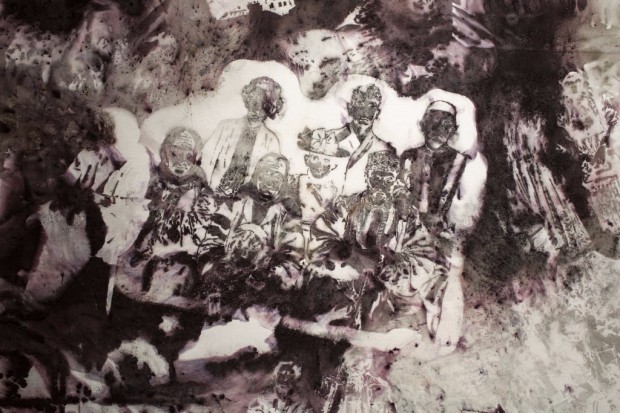
Detail of River, 2017. Gunpowder on canvas; 13 panels; 3 x 20 m. Photo by Tatiana Gontan, courtesy The Pushkin State Museum of Fine Arts.
A bilingual catalogue in English and Russian will be available at the end of September. In addition to numerous images detailing the process and outcome of the exhibition, the catalogue will also include Cai’s stirring personal essay “A Boy’s October” and scholarly contributions by Alexandra Danilova, Alexander Etkins, Boris Groys, Lars Nittve. The catalogue integrates personal, historical, artistic and political perspectives, echoing and responding to the themes and questions raised by the exhibition.
This November, the exhibition will unveil a documentary film of the same name, directed by Shanshan Xia. The film not only details the many stories behind the making of the exhibition, but also presents Cai’s search of the Russian painter Konstantin Maksimov. It hopes, through the narrative of these two artists, to candidly address the vacillation and persistence of artists during changing times.
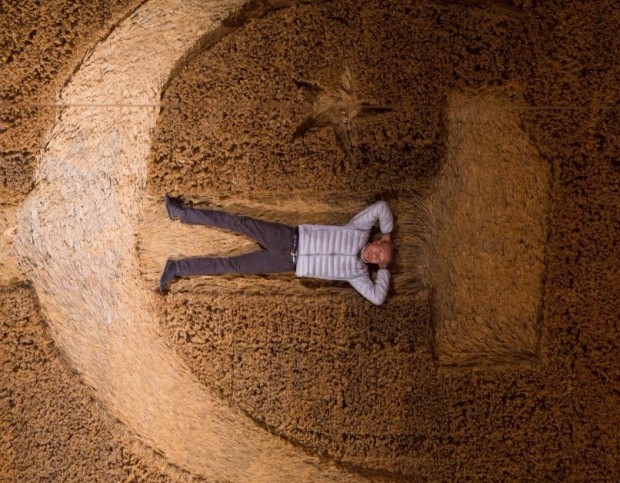
Cai Guo-Qiang in Land, The Pushkin Museum of Fine Arts, Moscow, 2017. Photo by Yvonne Zhao, courtesy Cai Studio
For more information:
Pushkin State Museum of Fine Arts
• http://www.arts-museum.ru/
• Facebook: https://www.facebook.com/theartsmuseum/
• Instagram: theartsmuseum
Cai Studio
• http://www.caiguoqiang.com/
• Facebook: http://www.facebook.com/cgqstudio/
• Instagram: caistudio
Cai Guo-Qiang Unveils Large-Scale Installation in Kyoto: A Tongue-in-Cheek Examination of East Asian Relations Today
Posted by Cai Studio in Uncategorized on August 21, 2017

Bonsai Ship, 2017. Photo by Tatsumi Masatoshi, courtesy of Cai Studio
KYOTO, JAPAN—On August 19, artist Cai Guo-Qiang introduces Bonsai Ship, a visually spectacular installation created specifically for the UNESCO World Heritage Site Nijo Castle, as part of the Asia Corridor Contemporary Art Exhibition within Culture City of East Asia 2017 Kyoto. The composition of the artwork is founded on a traditional Chinese wooden vessel, which has been reassembled on top of three massive boulders to contain five full-sized pine trees, forming an immense “bonsai” display of over 12m in height.
Towering in the Central Courtyard of Nijo Castle’s palace grounds, Bonsai Ship at once harmonizes with and stands distinct from the surrounding 17th-century architecture. The pines and boulders were carefully selected for their resemblance to landscapes in shanshui ink wash painting, an ancient Chinese artistic tradition that later expanded to Japan and Korea. The installation thus utilizes the imagination and formal expression of contemporary art, while at the same time humorously evoking the history and present state of East Asia.
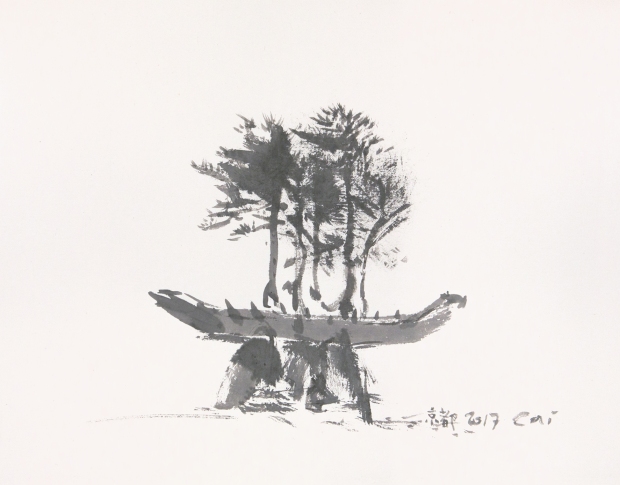
Cai Guo-Qiang, Sketch for Bonsai Ship, 2017. Ink on paper. Courtesy of Cai Studio
Bonsai Ship can be traced back to Cai’s earlier project To Build a Ship, which took part in Culture City of East Asia 2016 Nara. As a work that merged performance and installation art, To Build a Ship brought a team of Chinese shipbuilders to Nara’s historic temple Todai-ji, where they constructed a 13m-long traditional junk boat on-site. The building process was open to the public and, upon completion, the fully functional vessel floated on Todai-ji’s Mirror Pond for several months.

Shipbuilders working on To Build a Ship, 2016. Photo by Tatsumi Masatoshi, courtesy Cai Studio
Not unlike the progression of human history, this same ship has now arrived in Kyoto to become Bonsai Ship. Discussing the two projects, Cai Guo-Qiang states: “To Build a Ship, realized at Nara’s Todai-ji, was a project that allowed viewers to transcend the boundaries of space-time; it prompted us to reinterpret the course of history and rethink the time that we live in. It symbolized the mutual inheritance and influence that East Asian cultures have had on one another for centuries. In face of the difficult realities that now exist among these nations, the project raised the question: Can we continue sailing in this ship together?”
“Today, the ship has reached Kyoto, integrating with the environment of Nijo Castle to become the fantastical and miraculous Bonsai Ship. Taking on a humorous tone, it asks: ‘The spirit of Eastern philosophy and the ambitions of peace embodied by the Culture City of East Asia — are these simply an immense bonsai display?’”

To Build a Ship, 2016. Photo courtesy Culture City of East Asia 2016 Nara

Bonsai Ship, 2017. Photo by Lin King, courtesy of Cai Studio
Asia Corridor Contemporary Art Exhibition is hosted by Kyoto City in collaboration with the Japan Agency of Cultural Affairs and the Kyoto Art Center. Its Art Director and renowned curator Tatehata Akira said of Bonsai Ship: “As the title suggests, it is literally a massive ‘bonsai boat’ that invites laughter with its nonsensical humor … it is an artwork that makes a ‘spectacle of civilization’ on a large scale that is very characteristic of Cai.”
Bonsai Ship will be on view until October 15, 2017.
Culture City of East Asia 2017 Kyoto: Asia Corridor Contemporary Art Exhibition
Venue: Nijo Castle, Kyoto Art Center
Dates: August 19 – October 15, 2017
Hours: Nijo Castle opens every day from 8:45 a.m. – 5 p.m. (Last Admission: 4 p.m.)
Kyoto Art Center opens every day from 10:00 a.m. – 8:00 p.m.
For more information please visit:
- http://asiacorridor.org/
- www.facebook.com/cgqstudio/
- Instagram: @caistudio
- WeChat: 蔡国强工作室
About Culture City of East Asia
Culture City of East Asia is a tri-national collaboration that takes place annually in cities selected by the governments of Japan, China and South Korea as a series of yearlong cultural and arts events and exchange projects. The program aims to further the development of the host cities, as well as promote mutual understanding and solidarity in the region through the power of culture. Alongside fellow 2017 host cities Changsha (China) and Daegu (South Korea), Kyoto will organize a wide range of events, including traditional culture, contemporary art, performing arts, music, manga, and anime. Previous host cities include Quanzhou, Qingdao and Ningbo in China; Yokohama, Niigata and Nara in Japan; and Guangju, Cheongju and Jeju in South Korea.
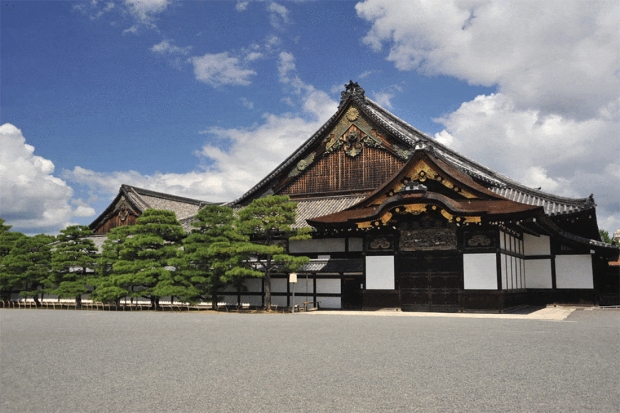
Nijo Castle, photo courtesy of Asia Corridor Contemporary Art Exhibition
About Nijo Castle
Nijo-jo, or Nijo Castle, was constructed by the Tokugawa shogunate during the Edo period (1603–1868). Construction first began in 1603 under the first-ever shogun, Ieyasu, and was extended in 1626 by the third shogun, Iemitsu. The castle later served as the Kyoto prefectural government and as a villa for the imperial family. Its grounds, surrounded by a moat stretching approximately 500m east to west and 400m north to south, are a designated National Historic Site and were registered as a UNESCO World Heritage Site in 1994. The existing Ninomaru Palace (a National Treasure) comprises six buildings made in the shoinzukuri architectural style that conveys the sophistication of Momoyama-period art through its sculptures and ornaments. It houses 3,600 wall paintings of the Kano school, 1,016 of which have been designated as Important National Treasures. Nijo Castle occupies a unique position in the history of the Edo Era; it hosted both the celebrations of the first shogun’s reign as well as the official transfer of power in 1867 from the last shogun to the emperor. 2017 happens to mark the 150th anniversary of the historic event.
About the Artistic Director
Born in 1947 in Kyoto, Tatehata Akira graduated with a degree in French literature from Waseda University in 1972. From 2005–11 he served as director of The National Museum of Art, Osaka, and was president of Kyoto City University of Arts from 2011–15. He has been director of Museum of Modern Art, Saitama since 2011 and president of Tama Art University since 2016. He specializes in modern and contemporary art. He has been involved with numerous Asian modern and contemporary art projects and international exhibitions, including the Venice Biennale, where he was commissioner for the Japan Pavilion in 1990 and 1993, and as artistic director for Yokohama Triennale 2001 and Aichi Triennale 2010.
Announcing “Cai Guo-Qiang: October” at the Pushkin State Museum of Fine Arts in Moscow
Posted by Cai Studio in Uncategorized on March 30, 2017
CAI GUO-QIANG: OCTOBER
Venue: The Pushkin State Museum of Fine Arts main building (Volkhonka, 12, Moscow, Russia)
Exhibition dates: September 12 – November 12, 2017

October, calligraphy by Cai Guo-Qiang , 2017. Courtesy of Cai Studio
In September 2017, the Pushkin State Museum of Fine Arts will present leading international contemporary artist Cai Guo-Qiang’s first solo exhibition in Russia: Cai Guo-Qiang: October. A reflection on the 100th anniversary of the Russian Revolution, the ambitious body of work originally created for the exhibition will transform the main exhibition areas of the museum.
The exhibition is a comprehensive introduction of the artist’s diverse yet distinctive practice to the Russian art world and local audiences. Artworks include large-scale outdoor and indoor installations, gunpowder paintings, a multi-media video installation, and small-scale sculptures and sketches. Upon entering the courtyard, visitors are greeted by a grandiose outdoor installation on the central staircase leading to the entrance of the museum, titled Autumn. A man-made mountain composed of birch trees and hundreds of baby cradles donated by Moscow residents, towers over the visitors and offers an astounding visual impression. For some, it will evoke a famous scene from Battleship Potemkin (1925) by Sergei Eisenstein.
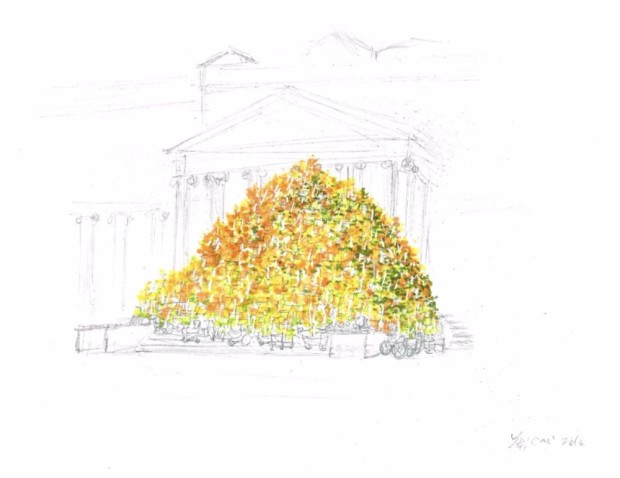
Cai Guo-Qiang, Sketch for Autumn, 2016. Courtesy of Cai Studio
The various artworks trace the artist’s personal journey: growing up in Communist China, later moving to Japan and now residing in the US, he has never ceased to expand his artistic activities to various parts of the world by collaborating with local communities, which is an important part of Cai Guo-Qiang’s projects. Ordinary people are often involved, and are able to relate to his artworks on a deeply personal level. In Moscow, Cai Guo-Qiang will continue to pursue this artistic methodology, and will create two 20-meter-long gunpowder paintings and one calligraphy on silk, all involving the participation of local residents. With his signature medium of gunpowder, Cai Guo-Qiang continues to transform this ancient Chinese invention, approaching it with modern technology and a contemporary attitude. His creative process comments on the continuity of history, its everlasting quality, which is also a theme evoked in this exhibition.
Marina Loshak, Director of the Pushkin State Museum of Fine Arts:
“The exhibition, dedicated to the Centenary of the Revolution, will be created in the form of a dialogue between contemporary art and the architecture of a classical museum, a finished work and the history of its creation, past events and the hopes of today.”
Conceived upon the centenary of the October Revolution, the exhibition considers the subjects of history, revolution and utopian dreams. According to Cai Guo-Qiang, “These topics should not stay as grand narratives of ideologies or social systems. Instead, we need to discuss more specifically how ‘the people’ is composed of many individuals. Whether prosperous or unfortunate, history is created by individuals, who must take responsibility and assume consequences. ‘Why do people have ideals?’ ‘How do we realize them?’ These kinds of questions are not only directed at the past, but also at the present. They are not only directed at China and Russia, but at the entire world.”
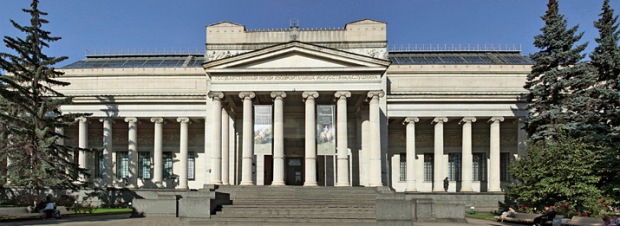
About the Pushkin State Museum of Fine Arts
The Pushkin State Museum of Fine Arts is a museum complex that is currently in possession of the largest world art collections in Moscow, Russia. Today, around 700,000 art works from different epochs are present in the Pushkin museum’s collection, ranging from Ancient Egypt and Greece up until the beginning of XXI century. The assemblage of XIX-XX century French art is most exceptional in the museum and one of the most distinguished ones in the world. The Pushkin State Museum of Fine Art attempts to engage modernity and classic art works in a mutual dialogue, as well as offer its original perception on widely recognized art pieces.
The Pushkin State Museum of Fine Arts Press Office
+7 916 457 91 13
Elena Antonova
press@arts-museum.ru
www.arts-museum.ru
Cai Guo-Qiang Solo Painting Exhibition at the Prado Museum: Exploring the Spirit of Painting
Posted by Cai Studio in Uncategorized on March 15, 2017
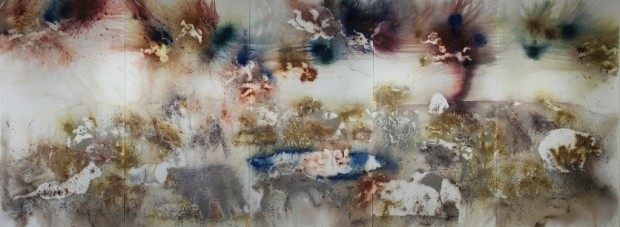
Cai Guo-Qiang, Last Carnival, 2017. Gunpowder on canvas, 280 x 750 cm. Photo by Yvonne Zhao, courtesy Cai Studio
The Prado Museum announces a solo exhibition by contemporary artist Cai Guo-Qiang. Cai Guo-Qiang at the Prado: The Spirit of Painting will be open from October 24, 2017 to March 4, 2018. This will be the second solo exhibition by a living artist since the museum’s founding in 1819, following an exhibition by the late Cy Twombly organized in 2008. The Spirit of Painting is co-curated by the museum’s director Miguel Zugaza and senior curator Alejandro Vergara.
The Prado houses one of the world’s greatest painting collections, and holds the most comprehensive and definitive collection of Spanish painting and sculpture. It is especially known for its collection of works by Titian, Bosch, Rubens, El Greco, Velazquez, and Goya.

Cai Guo-Qiang, Mountain in Heat, 2016. Gunpowder on canvas, 239 x 450 cm. Photo by Yvonne Zhao, courtesy Cai Studio
Inspired by the spirit and glory of painting that resides in this 200-year old museum’s collection from the Spanish Golden Age, Cai Guo-Qiang embarks on a journey to discover the spirit of his own painting, and raises questions on the current predicaments of contemporary painting. By engaging in a dialogue with the Prado’s expert staff and collection, he strives to establish his roots in the painting tradition. Through the works in this exhibition, he seeks to re-envision the spirit of painting, while remaining true to his methods.
Visitors will learn about Cai Guo-Qiang’s enduring dialogue with El Greco, which has inspired him from a young age. This includes Cai’s early paintings that were heavily influenced by El Greco, and documentation from his 2009 pilgrimage that retraced El Greco’s life from his hometown in Crete, to Venice, Madrid, and finally to his resting place in Toledo.
Cai Guo-Qiang will use his unique artistic method to demonstrate his pursuit of the spirit of painting found in the techniques, subjects, and sensibilities of great masters such as Titian, El Greco, Velazquez, Rubens, and Goya. Through more than twenty gunpowder paintings of varying scale, visitors will witness the artist’s experimentation with painting techniques and local gunpowder materials, his sketches, and in depth research that reveal the process behind each paintings on display.

Cai Guo-Qiang, Palmyra, 2017. Gunpowder on canvas, 240 x 450 cm. Photo by Wen-You Cai, courtesy Cai Studio
Beginning in late September this year, Cai Guo-Qiang will create the majority of paintings on-site in the historic Salón de Reinos (Hall of Realms). Over 400 years ago, Rey Planeta (King of the Planet) Philip IV received envoys from every realm in this formidable venue. He commissioned the most eminent painters in Spain and Europe, including Velazquez, to create paintings for the Salón de Reinos, engaging these masters in fierce artistic competition. The Hall was later transformed into a military museum. For Cai Guo-Qiang, creating gunpowder paintings in the Salón de Reinos becomes a site-specific event, one that travels through time, revisiting shadows of the distant past and challenging the imagination and creativity of the present day. At dusk on October 23, Cai Guo-Qiang will explode the immense artwork The Spirit of Painting, which will be the centerpiece of the exhibition.
José Pedro Pérez Llorca, President of the Royal Board of Trustees of the Prado Museum, and José Manuel Entrecanales, Executive Chairman of ACCIONA, signed an agreement of collaboration today to offer support for the exhibition. Director Zugaza and the artist would like to extend their sincere gratitude to Mr. Silas Chou and Elena & Alberto Cortina for their special contributions to the exhibition.
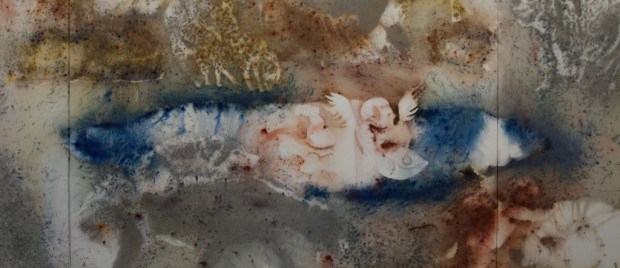
Cai Guo-Qiang, Detail of Last Carnival, 2017. Gunpowder on canvas, 280 x 750 cm. Photo by Lydia Ohl, courtesy Cai Studio
Exhibition Information
Cai Guo-Qiang at the Prado: The Spirit of Painting
Curator: Miguel Zugaza, Director of the Prado Museum; Co-Curator: Alejandro Vergara, Senior Curator at the Prado Museum
Organizer: Prado Museum
Location: Prado Museum, Madrid, Spain
On-Site Creation: Late September, 2017 to October 23, 2017 at the Salón de Reinos, Madrid, Spain
VIP Opening: October 24, 2017
Exhibition Dates: October 25, 2017 to March 4, 2018
About the Prado Museum and the Salón de Reinos

The Prado was established in Madrid, Spain in 1819, and is recognized for having the world’s greatest collection of paintings; it is also the museum with the most comprehensive and definitive collection of Spanish painting and art. Its collection currently comprises more than 30,000 historically significant pieces, around 8,000 of which compose the highest quality collection of painting in the world. The Prado is especially renowned for its significant collection of Titian, Bosch, and Rubens, as well as its comprehensive collection of the three great painters of Spain: El Greco, Velazquez, and Goya. Since the 20th century, the Prado has continued to expand and renew itself, and is now the singular most important hallmark of Spanish culture and art.
The Salón de Reinos (Hall of Realms) was built between 1630-1635; it is one of the very few structures that remain of the Palacio del Buen Retiro (Buen Retiro Palace) of Philip IV of Spain (1605-1665). The name of the Hall originates from the coat of arms of the 24 kingdoms that composed the Kingdom of Spain under Philip IV. The Salón de Reinos once housed the largest collection of paintings owned by Spanish royalty, all of which have entered the Prado’s collection. It was later transformed into a military museum until the early 21st century, when the Spanish Ministry of Culture designated it to become part of the Prado. In 2016, the Prado announced that Pritzker Prize-winner architect Norman Foster would direct the renovation of the Hall, currently set to begin in late 2018. Philip IV once received the envoys of countless “realms” in the very space where Cai Guo-Qiang will create gunpowder paintings; he also commissioned the most eminent European painters at the time to create paintings for the space, including masterpieces such as Velazquez’s tour de force The Surrender of Breda.

Left: Computer rendering of the Salón de Reinos in the Buen Retiro Palace during the 17th centuryRight: Photo of the Salón de Reinos in the Buen Retiro Palace. Courtesy Museo del Prado
About the Artist

Cai in front of Velázquez’s Las Meninas, Spain, 2017. Photo by Javier Molina, courtesy Prado Museum
Cai Guo-Qiang was born in 1957 in Quanzhou, Fujian Province, China. From 1981 to 1985, he trained in stage design at the Shanghai Theater Academy. His artistic expression spans multiple mediums including painting, installation, video, and performance. While living in Japan from 1986 to 1995, he explored the properties of gunpowder in his drawings, an inquiry that eventually led to his experimentation with explosives on a massive scale and to the development of his signature explosion events. Drawing upon Eastern philosophy and contemporary social issues as a conceptual basis, these projects and events aim to establish an exchange between viewers and the larger universe around them, utilizing a site-specific approach to culture and history.
Cai’s accolades include the Golden Lion at the 48th Venice Biennale in 1999, the Hiroshima Art Prize in 2007, and the 20th Fukuoka Asian Culture Prize in 2009. In 2012, He was honored as a laureate for Lifetime Achievement in the Arts in Painting by the prestigious Praemium Imperiale, an award that recognizes lifetime achievement in the arts in categories not covered by the Nobel Prize. In the same year, he was selected as one of the five artists who received the first U.S. Department of State Medal of Arts award for his outstanding commitment to international cultural exchange. His more recent honors include: the Barnett and Annalee Newman Foundation Award in 2015, the Bonnefanten Award for Contemporary Art (BACA) 2016, the Japan Foundation Award in 2016, and the Asia Art Award in 2016. Cai also served as Director of Visual and Special Effects for the Opening and Closing Ceremonies of the 2008 Summer Olympics in Beijing.
For the past three decades, his art has been featured in almost all major international exhibitions, and he has held solo exhibitions in numerous world-famous art institutions, among them Cai Guo-Qiang on the Roof: Transparent Monument at the Metropolitan Museum of Art, New York, 2006 and his retrospective I Want to Believe, which opened at the Solomon R. Guggenheim Museum, New York in 2008 and later travelled to the National Art Museum of China and the Solomon R. Guggenheim Museum, Bilbao, among others. In October 2013, Cai created One Night Stand (Aventure d’un Soir), an explosion event for Nuit Blanche, a citywide art and culture festival organized by the city of Paris. Also in 2013, his solo exhibitionDa Vincis do Povo, went on a three-city tour around the country in 2013. Traveling from Brasilia to São Paulo before reaching its final destination in Rio de Janeiro, it was the most visited exhibition by a living artist worldwide that year with over one million visitors.
On June 15, 2015, Cai realized his most recent explosion event Sky Ladder off of Huiyu Island, Quanzhou, China. His latest solo exhibition, Cai Guo-Qiang: My Stories of Painting opened in September 2016 at the Bonnefantenmuseum Maastricht in the Netherlands.
He currently lives and works in New York.
For more information, please follow:
Cai Studio
- www.caiguoqiang.com
- www.facebook.com/cgqstudio/
- Instagram: caistudio
- Wechat:蔡国强工作室
Prado Museum
- https://www.museodelprado.es/en
- www.facebook.com/museonacionaldelprado/
- Instagram: museoprado
Cai Guo-Qiang Honored At The 2016 Japan Foundation Awards
Posted by Cai Studio in Uncategorized on October 21, 2016
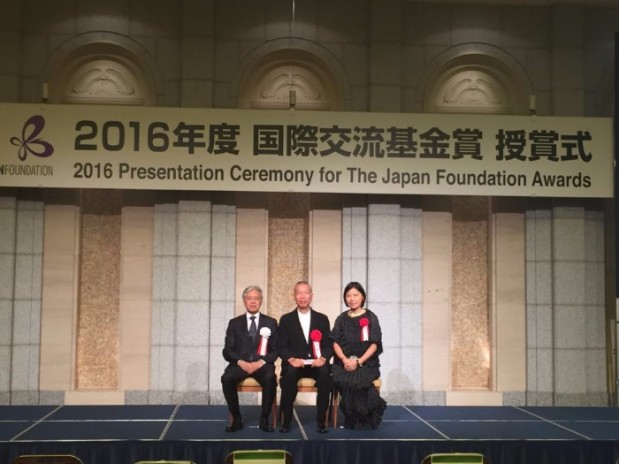
Left to right: Hiroyasu Ando (President of the Japan Foundation), Cai Guo-Qiang and his wife Hong Hong Wu. Photo courtesy of Cai Qiongzhu
On October 18, Cai Guo-Qiang received the 2016 Japan Foundation Award in Tokyo, becoming the second artist after Ikuo Hirayama (1930 – 2009) to be honored with this award. Hundreds of distinguished guests attended the ceremony, including diplomats from 60 countries and 25 members of the Japanese House of Councilors. This year the Japan Foundation Award was also presented to Professor Susan J. Pharr (Edwin O. Reischauer Professor of Japanese Politics and Director, Program on U.S.—Japan Relations, Weatherhead Center for International Affairs at Harvard University) and to the institution Centro Brasileiro de Língua Japonesa (CBLJ) in Brazil.
The annual Japan Foundation Awards were created in 1973 by the Japan Foundation, an independent administrative institution under the supervision of the Japanese Ministry of Foreign Affairs. With a 44-year history, the Awards comprise of a grant of 3 million yen. Over the years, they have been given to individuals as well as organizations that cultivate a mutual understanding and friendship between Japan and the world through academic, artistic, and other cultural endeavors. Previous notable Japanese recipients include Akira Kurosawa (1982), Seiji Ozawa (1988), Hayao Miyazaki (2005), and Haruki Murakami (2012).
The Japan Foundation devotes its attention to artists who contribute to promoting cultural exchange between Japan and other countries. On this occasion, the Foundation is recognizing Cai’s artistic practice around the globe, through which he creates works that integrate Eastern worldviews in dialogue with various regions including the Middle East and South America. Cai has always had a prominent presence in Japan. Since the Great East Japan Earthquake in 2011, he has sponsored the Iwaki Manbon Sakura Project. In 2015, his large-scale solo exhibition There and Back Again opened at the Yokohama Museum of Art, and more recently in March 2016, he initiated an collaborative project in which he invited craftsmen to build a wooden boat in the pond in front of Todaiji Temple in Nara, alluding to the possibility of Japan and China “sailing” with each other’s support. The Japan Foundation not only recognizes the artist’s efforts in connecting different regions and civilizations, but also honors his contribution to consolidating a global culture that transcends national boundaries and artistic practices.

Cai Guo-Qiang speaking at the award ceremony. Photo courtesy of He Yilan.
The President of the Japan Foundation Hiroyasu Ando presented the Awards and the Chinese Ambassador to Japan Cheng Yonghua attended the ceremony. In his reception speech, Cai stated:
“Every visit to Japan is a chance for me to think about the East, about Asia. In particular, the philosophical and artistic methodologies I’ve created with friends in Japan—methodologies that are multifaceted, harmonious, and coexist with nature in an East Asian context—have allowed me to move freely within different cultures, and create art in collaboration with different people.
I remember phoning Japanese costume designer Eiko Ishioka, inviting her to act as the director of costume design for the Beijing Olympics opening ceremony…To reassure her, I arranged for her office to be next to mine, so she only had to knock on the wall and I would be right over. I also asked my daughter, who speaks Japanese, to be her assistant, helping her out with her stay in China. The collaboration between Eiko Ishioka and the Chinese artists created the tremendous success of the Olympic opening ceremony.
A few years later, she passed away from an illness. Her husband told me that, in her final days, she had a picture of the ceremony director Zhang Yimou and myself up on the wall next to her bed.
Stories like the one I shared with Eiko Ishioka, as well as my experiences in Japan and throughout the world, all serve to prove how exchanges between individuals and cultures can transcend history, overcome political strife, and build a little bit of hope for the future.”

Left to right: Hiroyasu Ando (President of the Japan Foundation), Hong Hong Wu, Cai Guo-Qiang, and Cheng Yonghua (Chinese Ambassador to Japan). Photo courtesy of He Yilan.
For More Information
http://www.caiguoqiang.com/
www.facebook.com/cgqstudio/
Or subscribe to the Cai Studio WeChat “Cai Guo-Qiang Studio”
My Stories Of Painting Opening In The Netherlands
Posted by Cai Studio in Uncategorized on October 21, 2016
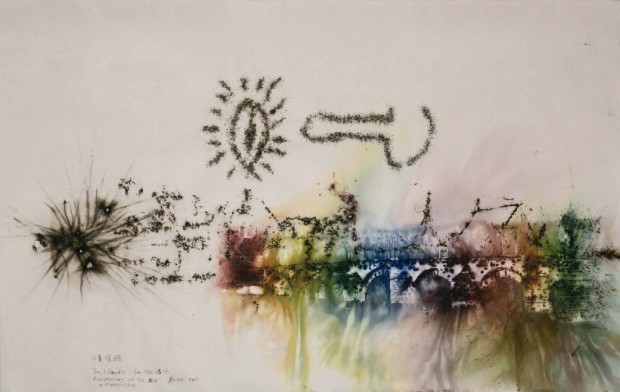
Cai Guo-Qiang, Boy’s Doodle: Drawing for the 25th Anniversary of the EU in Maastricht, 2016. Gunpowder on paper, 138 x 214 cm
Cai Guo-Qiang: My Stories of Painting
September 29 2016: Exhibition Opening and Presentation of the Bonnefanten Award 2016
Maastricht 23.08.2016 – On 29 September, the Bonnefanten Award for Contemporary Art 2016 (BACA) will be presented to Cai Guo-Qiang (1957, Quanzhou, Fujian, China). The BACA is the most important award for international visual art presented in the Netherlands, and it is awarded every two years since 2000. Consisting of a sum of 50,000 Euros, a publication and a solo exhibition, the Award is a tribute to a living non-Western artist with an exceptional oeuvre and a demonstrable influence on other artists, exhibition makers and art professionals. The Bonnefantenmuseum is presenting Cai Guo-Qiang’s first solo exhibition in the Netherlands: My Stories of Painting (30.09.2016 – 01.05.2017)

Left: Cai Guo-Qiang, Self-Portriat, 1983. Oil on canvas, 40 x 31 cm. Photo courtesy of Cai Studio. Right: Cai Guo-Qiang with Ascending Dragon: Project for Extraterrestrials No. 2, Japan, 1989. Photo courtesy of Cai Studio
Cai Guo-Qiang: My Stories of Painting
My Stories of Painting is the first exhibition that will focus on Cai’s long journey of painting in terms of two parallel paths. The first traces his restless exploration in painting by presenting over a hundred works of various periods, scales and mediums — many of which are shown for the first time. The exhibition begins with his time in China: watercolours and oil paintings, school assignments, experimental paintings, and oil paintings with gunpowder; followed by his time in Japan: paintings created only with gunpowder, and gunpowder drawings for explosion events; it then moves on to his time in New York and the global stage — works reflecting his unique challenge to the issue of painting through his consistent artistic methodology, including recent pieces following his return to creating independent gunpowder paintings. Evolving from black gunpowder to color gunpowder, this new stage registers the artist’s unrestrained pursuit of his childhood dream to become a painter as well as his confrontation with the integral challenges of contemporary painting.
The second path is that of his family: his grandmother, parents, wife, and daughters. Through their paintings, photography, and other works, viewers can see how generation after generation, the artist’s family accompanies and mutually influences Cai. In addition to the exhibition’s scholarly consideration of the artist’s paintings, the viewers will experience the intimate and arduous sides of a painter’s journey. Crossing the boundaries between cultures, the exhibition will resonate widely with audiences, and will be an important milestone in Cai’s decades-long exploration of painting.
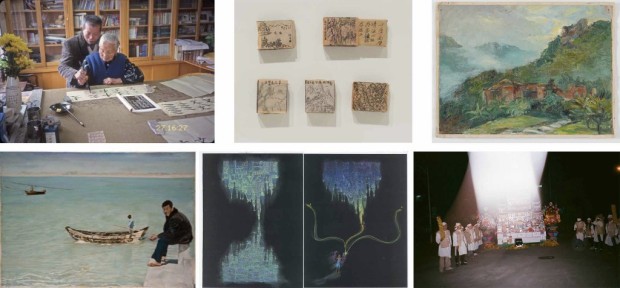
Top: Cai Guo-Qiang’s father teaching his grandmother calligraphy, Quanzhou, date unknown; Cai Ruiqin (Father), Untitled (Matchbox Drawings), date unknown. Ink, pen, and pencil on cardboard matchboxes, dimensions variable; Painting of Ci-En Temple where Cai Guo-Qiang’s mother would go to pray. Photo by Ron Amstutz, courtesy of Cai Studio*Bottom: Hong Hong Wu (Wife), Sea Breeze, date unknown. Oil on canvas, 33 x 46 cm; Wenhao Cai (Younger Daughter), Wenhao’s Dream: Creative Sketches for Shanghai Disney Resort, 2015. Set of 26 drawings; oil pastel on paper; each 21.6 x 27.9 cm; Wen-You Cai (Elder Daughter), With the Whole Family, in Preparation of Burning Grandfather’s Paper House for his Afterlife, 2016. C-print; 40.6 x 61 cm. Quanzhou, China.
*All other photos Courtesy of Cai Studio.

Cai Guo-Qiang, Poppy Series: Hallucination No.1, 2015. Gunpowder on canvas,183 x 608 cm. Private Collection.
Catalogue
Cai Guo-Qiang: My Stories of Painting will be accompanied by a catalogue of the same title, available in English and Dutch published by Walther König Publisher. It includes essays by Cai Guo-Qiang, Bonnefantenmuseum director Stijn Huijts, as well as the former director M+ museum in Hong Kong, Lars Nittve.
Bonnefanten Award for Contemporary Art (BACA) 2016
In presenting the exhibition and publication by BACA laureate Cai Guo-Qiang, the Bonnefantenmuseum is once again drawing attention to an exceptional and influential oeuvre within contemporary art and introducing the public to a relevant, yet for many people an unfamiliar chapter of art history. Cai Guo-Qiang was awarded the BACA 2016 by a unanimous vote. The international selection committee for 2016 comprised of Cao Fei (artist), Stijn Huijts (Bonnefantenmuseum director), William Lim (architect, collector), Carol Lu (curator, writer), Lars Nittve (former director M+ Museum Hong Kong) and Uli Sigg (collector).
Invitation to the press preview
The museum invites members of the press to the preview of Cai Guo-Qiang: My Stories of Painting on Thursday 29 September between 11:00am – 12:30pm. Please rsvp via pressoffice@bonnefanten.nl. For further information and visual material, please contact Lieke Heijmans, +31(0) 6 27 494 829, heijmans@bonnefanten.nl.
For more information about the artist and the exhibition, please visit:
http://www.caiguoqiang.com/
http://www.bonnefanten.nl/en/
Support
The BACA and Cai Guo-Qiang: My Stories of Painting receives generous support from the Province of Limburg, DSM, the Bankgiro Loterij, the Mondriaan Fund, the VSBFonds, the Prins Bernhard Cultuurfonds and the Cultural Heritage Agency of the Netherlands.
Sky Ladder: The Art of Cai Guo-Qiang Receives Critical Acclaim Following Worldwide Release
Posted by Cai Studio in Uncategorized on October 21, 2016

Film stills taken from documentary Sky Ladder: The Art of Cai Guo-Qiang, all images courtesy Netflix
On October 13, 2016, Sky Ladder: The Art of Cai Guo-Qiang—the first full-length documentary feature on Cai Guo-Qiang—premiered at Sotheby’s New York headquarters, attended by more than two hundred distinguished guests. As of October 14, the film appears in cinemas in New York and Los Angeles and is distributed in 190 countries via Netflix. Sky Ladder instantly caught the attention of the press and was reviewed by nearly fifty publications including The New York Times, The Los Angeles Times, The Wall Street Journal, The Guardian, and Vogue.
“Some of Cai Guo-Qiang’s art exists for mere moments. But my, how long it sticks in the mind. That enchantment is at the center of ‘Sky Ladder: The Art of Cai Guo-Qiang,’ a documentary that is as rewarding as this artist’s work.”
“It’s no spoiler to reveal that ‘Sky Ladder,’ the art project, eventually succeeds, and its fleeting existence is magnificent. It says something about the work, and perhaps about life, that brevity adds an element that’s both magical and saddening.”
“Though if you watch Mr. Cai’s works on video, you can always rewind.” —The New York Times
“A documentary that begs to be seen in a theater…‘Sky Ladder: The Art of Cai Guo-Qiang’ offers an inviting glimpse into the life of a truly international artist, one whose colorful fireworks displays literally paint the air…Kevin Macdonald’s beautifully shot, quietly hovering portrait is of a pensive, dogged man…” —The Los Angeles Times
“The documentary Sky Ladder: The Art of Cai Guo-Qiang was shot by Wes Anderson collaborator Robert Yeoman, who captures the beautiful, cacophonous (even terrifying) explosions, and the more sedentary moments of Cai’s everyday life with equal grace.” —Vogue
“Nothing typifies the toweringly celestial ambition of the Chinese contemporary artist Cai Guo-Qiang than his ‘sky ladder’, a project over 20 years in the making.” —The Guardian
“Cai’s grandmother watches [Sky Ladder] unfold via an iPad, after which the artist breathlessly asks her, ‘Isn’t your grandson awesome?’ It’s a beautiful, touching moment that says more about the artistic urge than any scholarly tome ever could.” —Hollywood Reporter
“Perhaps Cai‘s most compelling, personal work yet… As the massive sculpture ignites, it creates a fiery vision that miraculously ascends to the heavens…Chances to see such work in person are rare, but the film offers something even more special…” —Artnet News
“Macdonald effectively draws lines between his subject’s past and his present, attempting to make sense of what his harshest critics see as self-serving contradictions. In a way, it’s all of a piece, embracing the best and worst of an ever-changing nation.” —AV Club
“[…] the film hopes to catch the eye of Oscar voters. And frankly it stands a great chance of being nominated for Best Documentary, with its astute coverage of the artist, his groundbreaking work, his family, including his 100-year-old grandmother, and Mao’s China.” —Blasting News
Sky Ladder: The Art of Cai Guo-Qiang is scheduled to be released in China in November.
Watch the Film:
Online: Netflix.com
In Theaters:
IFC Center (New York)
Show times: October 14 – 20, 1:15pm, 2:50pm, 4:25pm, 6:05pm
Address: 323 6th Ave, New York, NY 10014
Ticket purchase: http://www.ifccenter.com/films/sky-ladder-the-art-of-cai-guo-qiang/
Playhouse 7 (Los Angeles)
Show times: October 14 – 20, 11:00am, 1:00pm, 4:00pm, 6:00pm, 8:00pm, 10:00pm
Address: 673 East Colorado Blvd., Los Angeles, CA 91101
Ticket purchase: http://www.laemmle.com/films/41009
For More Information
http://www.caiguoqiang.com/
www.facebook.com/cgqstudio/
Or subscribe to the Cai Studio WeChat “Cai Guo-Qiang Studio”
Sky Ladder: An Explosive Documentary On Artist Cai Guo-Qiang
Posted by Cai Studio in Uncategorized on October 21, 2016
Sky Ladder: The Art of Cai Guo-Qiang is a narrative documentary film directed by Academy Award winner Kevin Macdonald and produced by Wendi Deng Murdoch, Hugo Shong, and Fisher Stevens. The 70-minute feature will debut as a Netflix original film, and will be available in over 190 countries starting October 14, 2016. It will be the first full-length documentary feature on Cai, one of the world’s most influential contemporary artists.
The documentary will also be on view in New York from October 14 – 20 at the IFC Center:
323 6th Ave, New York, NY 10014
1:15 pm, 2:50 pm, 4:25 pm, 6:05 pm
Tickets: http://www.ifccenter.com/films/sky-ladder-the-art-of-cai-guo-qiang/
Known for his work with gunpowder and fireworks, Cai Guo-Qiang’s explosive artwork has long amazed audiences all over the world. His works, which include drawings, paintings, installations, and explosion events, have been exhibited in almost every major art destination around the globe. While founded in Eastern philosophy, his artistic projects adopt ever-expanding forms of artistic expression and interpretation that respond to local cultures, histories, and various issues in modern society.
Director Kevin Macdonald spent two years with Cai, taking an in-depth look at the artist’s work and daily life while following him from New York to Buenos Aires, Shanghai, Beijing, Liuyang, and his hometown of Quanzhou. Told through the eyes of family, friends, collaborators, art experts, and Cai himself, along with rare footage selected from the artist’s archives, Sky Ladder follows Cai’s meteoric rise on the international stage. It is a dazzling journey that culminates in his becoming an artist known for “lighting fires” all over the world: highlighted by the Opening Ceremony of the 2008 Beijing Olympic Games, his 2008 Guggenheim solo exhibition in New York, the 2013 explosion event One Night Stand on the banks of the Seine, the 2014 daytime explosion event Elegy in Shanghai—among many others. The film also delves into the harsh realities behind these spectacular visions: the struggles, compromises, vulnerabilities, love and family ties, as well as the artist’s complex and profound feelings toward his home and country.
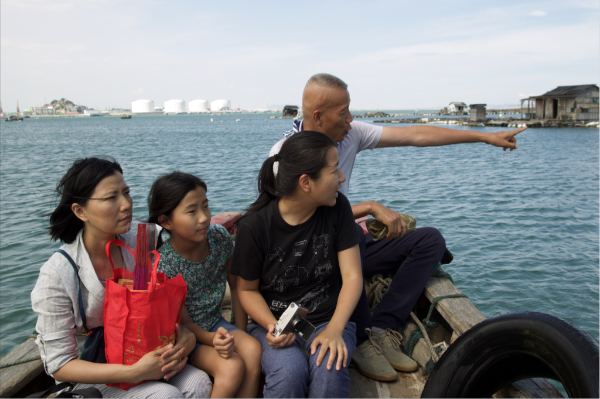

Top: Cai Guo-Qiang with his wife Hong Hong Wu and daughters arriving at Huiyu Island. Photo by Daxin Wu, courtesy Cai Studio; Bottom: Sky Ladder preparation process, 2015. Photo by Wen-You Cai, courtesy Cai Studio
At the heart of the film is Sky Ladder, a 500-meter ladder of golden flames that hissed and roared its way from the shore of a small fishing village in Quanzhou up into the blue sky and the infinite universe beyond. This is the realization of Cai’s childhood dream—a dream to connect with the stars—one that has been attempted multiple times around the world, and one that he never stopped pursuing despite countless obstacles. In June 2015, he made yet another attempt. At dawn, with help from Chinese technical experts and hundreds of local villagers, Cai dedicated Sky Ladder as a gift to his one hundred-year-old grandmother and to his beloved hometown.
A story of one individual artist and his singular dream, Sky Ladder is also a film about undeniably universal human emotions. It has the power to move audiences from any culture or nation, as proven by responses at both the 2016 Sundance Film Festival and the 2016 BFI London Film Festival.
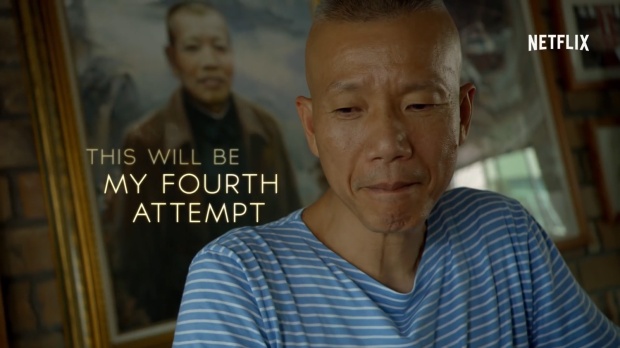
About the Filmmakers
Director Kevin Macdonald’s works include Academy Award Best Documentary One Day in September(1999), BAFTA Best British Film Touching the Void (2003), and Academy Award-winning feature film The Last King of Scotland (2006). Executive Producer Bennet Miller is known for directing Capote (2005), for which he was nominated for an Academy Award and a BAFTA; Moneyball (2011), which received six Academy Award nominations including Best Picture; and Foxcatcher (2014), for which he won Best Director at the Cannes Film Festival. Executive Producer Angus Wall is known for The Social Network(2010) and The Girl with the Dragon Tattoo (2011), for both of which he won the Academy Award for Best Film Editing. Producers include Wendi Deng Murdoch (television producer and co-founder of online art platform Artsy), Fisher Stevens (director and producer of over thirty films, including 2010 Academy Award Best Documentary The Cove), and Hugo Shong (Founding General Partner of IDG Capital Partners and renowned Chinese film producer). Assistant Director and Co-producer Xia Shanshan has worked with Cai Guo-Qiang for many years, and has produced numerous art documentaries including What About the Art? Contemporary Art from China (2016). Director of Photography Robert Yeoman is a longtime collaborator of world-renowned filmmaker Wes Anderson. He was the director of photography for numerous critically acclaimed features including Moonrise Kingdom (2012) and The Grand Budapest Hotel (2014).
Show Times, New York, October 14 – 20:
IFC Center, 1:15 pm, 2:50 pm, 4:25 pm, 6:05 pm
323 6th Ave, New York, NY 10014
Tickets: http://www.ifccenter.com/films/sky-ladder-the-art-of-cai-guo-qiang/
For More Information:
http://www.caiguoqiang.com/
http://www.facebook.com/cgqstudio/
Or subscribe to the Cai Studio WeChat “Cai Guo-Qiang Studio”
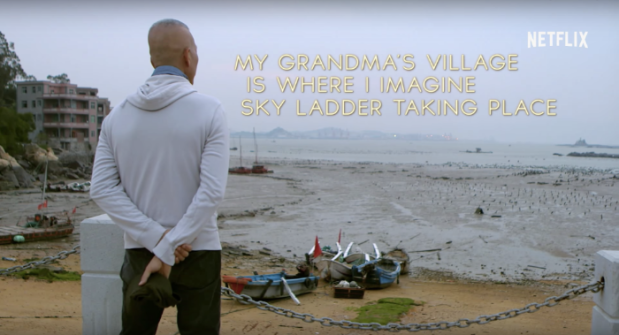



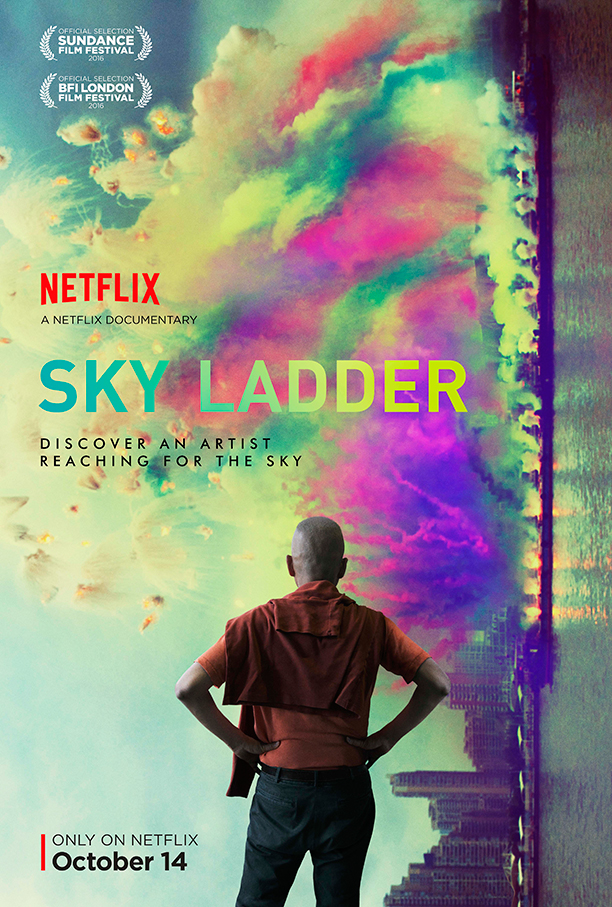

You must be logged in to post a comment.